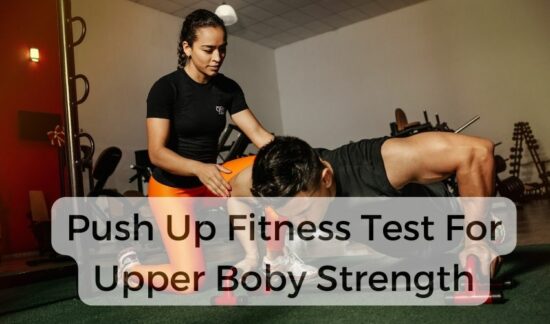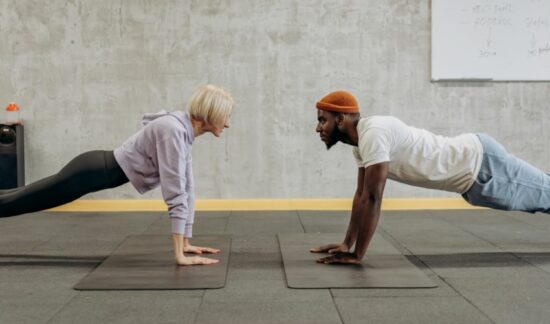Having a strong upper body is essential for overall fitness and functionality. One effective way to assess your upper body strength and endurance is through the push-up test. In this blog post, we will explore the benefits of upper body fitness, understand the push-up test, learn how to prepare for the test, perform it correctly, interpret the results, improve push-up performance, avoid common mistakes, modify the test for different needs, and incorporate it into your fitness routine. Let’s dive in!

Benefits of Upper Body Fitness
A strong upper body brings numerous advantages. Firstly, it improves posture and alignment, reducing the risk of musculoskeletal issues. Secondly, it enhances functional strength, making daily activities easier and more efficient. Additionally, a strong upper body enhances sports performance by enabling better power, agility, and coordination. Lastly, it helps prevent injuries by providing stability and support during physical activities.
Understanding the Push-Up Test
The push-up test is a widely recognized assessment tool for measuring upper body strength and endurance. It involves performing a series of push-ups to evaluate the muscles in your chest, shoulders, arms, and core. By measuring your performance, you can gauge your upper body fitness level and track progress over time.
Benefits of Upper Body Fitness With the Push-Up Test
Upper body fitness, when measured through the push-up test, offers a range of benefits that positively impact your overall health and well-being. Here are some key advantages:
- Strengthens Muscles: The push-up test targets multiple muscle groups, including the chest (pectoralis major), shoulders (deltoids), arms (triceps), and core. Regularly performing push-ups and improving your test score will lead to increased muscle strength and definition in these areas.
- Improves Upper Body Endurance: Endurance is the ability of your muscles to sustain effort over an extended period. The push-up test challenges your upper body to perform a continuous series of repetitions, which helps improve muscular endurance. This increased endurance can translate to improved performance in daily activities and sports.
- Enhances Posture and Alignment: A strong upper body contributes to better posture and alignment. The muscles targeted in the push-up test, such as the chest and back muscles, play a significant role in maintaining a tall and upright posture. Improved posture not only enhances your appearance but also reduces the risk of developing musculoskeletal issues, such as rounded shoulders or a forward head position.
- Boosts Functional Strength: Functional strength refers to the ability to perform everyday tasks with ease and efficiency. Push-ups engage muscles that are involved in various daily activities, such as pushing, pulling, and lifting objects. By developing upper body strength through the push-up test, you’ll experience enhanced functional strength, making tasks like carrying groceries, lifting objects, or pushing a stroller feel less challenging.
- Supports Sports Performance: Many sports and physical activities require upper body strength and power. By improving your upper body fitness through the push-up test, you’ll have a solid foundation for sports performance. Increased upper body strength and endurance can enhance your ability to throw, swing, lift, or perform movements specific to your chosen sport.
- Reduces the Risk of Injury: A well-developed upper body provides stability and support during physical activities, reducing the risk of injuries. The muscles strengthened through the push-up test help protect the joints, particularly the shoulders, by maintaining proper alignment and absorbing impact. Strong upper body muscles also assist in maintaining balance and preventing falls.
- Convenient and Cost-Effective: One of the significant advantages of the push-up test is that it requires minimal equipment and can be performed anywhere. You can engage in this assessment and exercise without the need for a gym membership or expensive equipment. Push-ups can be done at home, in a park, or during travel, making them a convenient and cost-effective way to improve upper body fitness.
- Promotes Overall Body Strength: While the push-up test primarily focuses on the upper body, it also engages muscles in the core, including the abdominals and lower back, to stabilize the body during the exercise. This comprehensive engagement leads to improved overall body strength and coordination.
By incorporating the push-up test into your fitness routine and working to improve your upper body fitness, you’ll reap these benefits and enjoy a stronger, more functional upper body that supports your overall health and performance in various physical activities.
Preparing for the Push-Up Test
Before attempting the push-up test, it’s crucial to prepare properly. Start with a warm-up routine that activates the muscles in your upper body. Dynamic stretches and mobility exercises are ideal for preparing your joints and muscles. Once warmed up, focus on mastering proper push-up form and technique, ensuring correct hand placement, shoulder alignment, and body positioning. Gradually build up your strength through progressive training and tailor the exercises to your fitness level and any limitations you may have.
Performing the Push-Up Test
To perform the push-up test accurately, follow these steps:
- Assume the starting position: Place your hands slightly wider than shoulder-width apart on the floor, fingers pointing forward. Extend your legs behind you, toes touching the ground. Keep your body in a straight line from head to heels.
- Lower your body: Bend your elbows and lower your chest towards the floor while maintaining a tight core and neutral spine. Aim to bring your chest as close to the ground as possible without touching it.
- Push back up: Extend your arms, pushing through your palms and returning to the starting position.
- Repeat: Perform as many push-ups as you can while maintaining proper form. Note the number of repetitions completed.
Interpreting Your Results
After completing the push-up test, it’s essential to interpret your results accurately. Your test score reflects your upper body strength and endurance level. Compare your results to standardized norms to assess where you stand. Analyze your performance to identify areas for improvement and set specific goals for your training.
Improving Your Push-Up Performance

To enhance your push-up performance, incorporate targeted strength training exercises into your workout routine. Focus on exercises that engage the muscles used in push-ups, such as chest presses, tricep dips, and planks. Gradually increase the difficulty of your workouts by adding resistance, using unstable surfaces, or trying advanced variations of push-ups. Develop a well-rounded upper body workout plan that addresses all major muscle groups, ensuring balanced strength development.
Common Mistakes and How to Avoid Them
During push-ups, it’s easy to fall into common form errors that compromise your results and increase the risk of injury. Avoid these mistakes by paying attention to proper hand and shoulder placement, maintaining a neutral spine, and engaging your core. Avoid excessive arching or sagging of the back, as it can strain the lower back and diminish the effectiveness of the exercise. Practice proper breathing techniques to optimize your performance and maintain stability throughout each repetition.
Modifying the Push-Up Test
The push-up test can be modified to accommodate individuals with specific needs or limitations. For those unable to perform traditional push-ups, alternative exercises can be used to assess upper body fitness. These modifications may include wall push-ups, knee push-ups, or push-ups on an inclined surface. Adjust the testing protocol to suit different populations, such as older adults, individuals with disabilities, or those recovering from injuries.
Push-Up Test for Different Fitness Levels
The push-up test can be tailored to different fitness levels, making it accessible for beginners, intermediate, and advanced individuals. Beginners may start with modified push-up variations and gradually progress to standard push-ups. Intermediate participants can aim for a specific number of repetitions within a time limit, while advanced individuals can challenge themselves with more difficult variations or weighted push-ups. It’s important to set realistic goals that align with your current fitness level and gradually work towards improvement.
Incorporating the Push-Up Test into Your Fitness Routine
To make the push-up test an integral part of your fitness routine, establish a regular testing schedule. Use the test as a benchmark to track your progress and monitor improvements in your upper body strength and endurance. Integrate push-ups into your regular upper body workout routine, ensuring proper form and technique. Continuously challenge yourself by setting new goals and adjusting your training accordingly.
Beyond the Push-Up Test: Assessing Overall Upper Body Fitness
While the push-up test is a valuable assessment tool, it’s important to consider other measures of upper body strength and endurance. Explore additional exercises and assessments that target different muscle groups and movement patterns. Recognize the limitations of the push-up test and supplement it with other tests, such as pull-ups, bench press, or functional movement assessments, for a comprehensive evaluation of your upper body fitness.
Safety Considerations
Prioritize safety when engaging in any exercise program, including the push-up test. If you have existing injuries or joint issues, consult with a healthcare professional or a certified fitness trainer before attempting the test. Listen to your body and avoid overexertion, gradually increasing the intensity and difficulty of your workouts. Always incorporate a proper warm-up and cool-down routine to prevent injuries and optimize performance.
Motivation and Accountability
Staying motivated throughout your fitness journey is crucial for long-term success. Set clear goals and track your progress to stay focused and committed. Celebrate your achievements and milestones, whether it’s an increase in the number of push-ups or improvements in overall upper body fitness. Engage with a support system or join a fitness community to find like-minded individuals who can offer encouragement, advice, and accountability.
Conclusion
The push-up test is a valuable tool for assessing and improving upper body fitness. By incorporating this test into your fitness routine, you can gauge your strength and endurance levels, set goals, and monitor your progress over time. Remember that upper body fitness goes beyond the push-up test, so explore various exercises and assessments to create a well-rounded upper body workout routine. Stay motivated, be consistent, and enjoy the journey of enhancing your upper body strength and overall fitness.
FAQs
The push up test is used to determine the strength and endurance of the upper body. During this portion of the evaluation, you will be required to do a set number of push-ups at a rate of one every three seconds.
The number of push-ups one can complete is a common indicator of upper-body strength. It is a straightforward and speedy method for determining a person’s strength and endurance. The exam requires the participant to complete as many push-ups as they can in the allotted time. The level of muscular strength is determined by counting the number of pushups that can be accomplished within the given amount of time.
Timed Test: A popular variation of the push-up test involves counting how many repetitions a person can complete in a predetermined amount of time, such as one or two minutes. The push-up exam for the United States Army takes place over a period of two minutes, whereas the test for the United States Navy takes place over a period of one minute. The variation known as Chair Push Ups counts the most reps that can be completed in thirty seconds.